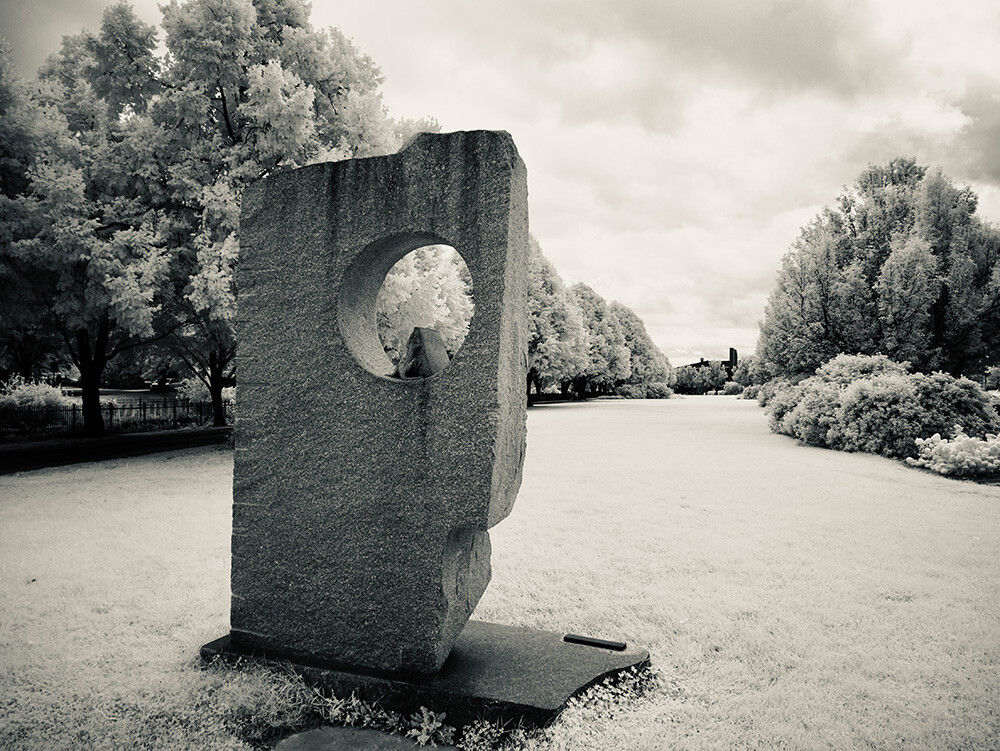Sensor size matters in Infrared
.jpg)
Share this post
Why Sensor Size Matters More Than Megapixels in Digital Infrared Photography
In the realm of digital photography, particularly infrared (IR) photography, the debate between sensor size and megapixel count is ongoing. While high megapixel counts are often touted as markers of image quality, for infrared photography, sensor size takes precedence. This discussion explores why sensor size is more critical than megapixels for digital infrared photography, why compact cameras with 1/2.3" sensors should max out at 16 megapixels—and sometimes even perform better with 10 to 12 megapixels—and why larger sensors like 1-inch or bigger deliver superior results even at lower megapixel counts.
Sensor sizes overlaid inside, CC BY-SA 3.0
Understanding Infrared Photography
Infrared photography captures light that is not visible to the naked eye, typically wavelengths from 700 nm to 1 mm. This unique spectrum allows photographers to reveal textures, patterns, and contrasts invisible in standard photography, making it a powerful tool for creative expression, scientific applications, and artistic endeavors.
However, IR photography poses specific challenges. Infrared light interacts differently with camera sensors compared to visible light, requiring precise sensor performance to capture clear and detailed images. This is where sensor size and quality become paramount.
Sensor Size vs. Megapixels: The Basics
Megapixels refer to the number of pixels a camera sensor has, directly influencing the resolution of the images. More megapixels can mean more detail, allowing for larger prints and greater cropping flexibility.
Sensor Size, on the other hand, pertains to the physical dimensions of the sensor. Larger sensors generally offer better light-gathering capabilities, improved dynamic range, and superior image quality, especially in challenging lighting conditions.
While both factors contribute to image quality, their impact varies depending on the photography style and requirements. In infrared photography, sensor size often outweighs megapixel count due to the unique nature of IR light capture.
Why Sensor Size Trumps Megapixels in IR Photography
-
Light Sensitivity and Noise Performance
-
Larger Sensors: Bigger sensors have larger individual pixels (photosites), allowing them to capture more light per pixel. This increased light sensitivity is crucial for IR photography, where the light spectrum is less intense and requires more precise detection. Additionally, larger sensors typically exhibit lower noise levels, resulting in cleaner images.
-
Smaller Sensors: Compact cameras with 1/2.3" sensors and high megapixel counts, especially exceeding 16 MP, have smaller individual pixels. Pushing the megapixel count higher on a small sensor results in more noise and reduced light sensitivity, which can degrade infrared image quality. In many cases, reducing the megapixel count to 10 or 12 on a 1/2.3" sensor can enhance performance by increasing pixel size, thereby improving light capture and reducing noise.
-
-
Dynamic Range
-
Larger Sensors: They generally offer a broader dynamic range, capturing more details in both shadows and highlights. This is essential in IR photography to handle the unique contrast and tonal ranges inherent to infrared images.
-
Smaller Sensors: Limited dynamic range can result in loss of detail, particularly in high-contrast IR scenes, making it harder to achieve the desired visual effects.
-
-
Image Quality and Detail
-
Larger Sensors: Provide better overall image quality with more accurate tone reproduction and finer detail, even if the megapixel count is lower.
-
Smaller Sensors: High megapixel counts can sometimes lead to image degradation, especially in IR photography where fidelity and detail are crucial.
-
-
Lens Performance and Compatibility
-
Larger Sensors: Most cameras with larger sensors, such as those with Micro Four-Thirds, APS-C or full-frame sensors, use interchangeable lenses. This is a significant advantage for infrared photography because it allows you to choose lenses that perform best for IR, avoiding the issue of "hotspots"—areas of uneven brightness or circular spots that can appear in the center of an infrared image with certain lenses.
Not all lenses are optimized for infrared use, and some produce these unwanted hotspots due to internal reflections or design elements. With an interchangeable lens system, you have the flexibility to test and select lenses that minimize these artifacts, ensuring better image quality. Additionally, higher-quality lenses optimized for larger sensors often offer superior sharpness, contrast, and light transmission, all of which enhance the overall performance of IR photography.
-
Smaller Sensors: Often limited to compact lenses, which might not deliver the same level of sharpness and contrast needed for superior IR photography.
-
Why Compact Cameras with 1/2.3" Sensors Should Max Out at 16 Megapixels
Compact cameras equipped with 1/2.3" sensors should ideally be limited to 16 megapixels for infrared photography, and sometimes even lower resolutions like 10 to 12 megapixels can perform better. Here’s why:
-
Avoiding Pixel Crowding: Cramming more than 16 megapixels into a 1/2.3" sensor reduces the size of each pixel, limiting its ability to capture light effectively. This results in poorer low-light performance, increased noise, and reduced image clarity—issues that are exacerbated in IR photography due to its reliance on capturing subtler wavelengths of light.
-
Balanced Light Sensitivity and Resolution: At 16 MP, a 1/2.3" sensor maintains a good balance between resolution and light sensitivity. Higher megapixels on this small sensor would compromise the ability to capture enough light, making IR images noisier and less detailed, particularly in shadowed or low-light areas. Reducing the megapixel count to 10 or 12 can enhance light sensitivity and reduce noise, leading to clearer and more detailed IR images.
-
Cost-Effectiveness and Practicality: Compact cameras with 1/2.3" sensors are popular for their portability and affordability. However, pushing beyond 16 MP introduces diminishing returns in image quality without significant benefits, making the additional cost unjustifiable for most IR photographers.
-
Manageable File Sizes: 16 MP provides enough resolution for most infrared photography use cases, producing manageable file sizes without the excessive data that higher megapixel counts would generate. Lower resolutions like 10 to 12 MP further reduce file sizes, allowing for faster processing, editing, and storage without sacrificing essential image quality.
The Superior Performance of Larger Sensors Even at Lower Megapixels
Larger sensors, such as 1-inch or bigger, may boast lower megapixel counts compared to compact cameras, but they deliver superior performance for several reasons:
-
Enhanced Light Capture: Bigger sensors capture more light, which is vital for IR photography. This results in images with richer tones, better depth, and greater clarity.
-
Improved Low-Light Performance: Larger sensors excel in low-light conditions, reducing noise and enhancing detail. IR photography often relies on low-light scenarios, making this a significant advantage.
-
Better Dynamic Range: With the ability to capture a wider range of light intensities, larger sensors handle the unique contrasts of IR scenes more effectively, preserving detail in both bright and dark areas.
-
Higher Image Quality: Larger sensors provide better color accuracy and finer detail rendition, essential for the nuanced tones and textures in infrared images.
Conclusion
In digital infrared photography, sensor size is a critical factor that significantly impacts image quality, more so than megapixel count. Compact cameras with 1/2.3" sensors should max out at 16 megapixels to ensure an optimal balance between resolution and sensor performance. In some cases, even 10 to 12 megapixels can offer better performance by enhancing light sensitivity and reducing noise. Exceeding this threshold on small sensors introduces noise, reduces light sensitivity, and ultimately degrades image quality.
For those seeking the highest quality, sensors of 1-inch or larger provide unparalleled light sensitivity, dynamic range, and overall image fidelity—even with fewer megapixels. Whether you prefer compact portability or professional-grade performance, choosing the right sensor size is key to capturing the ethereal beauty that infrared photography unveils.



